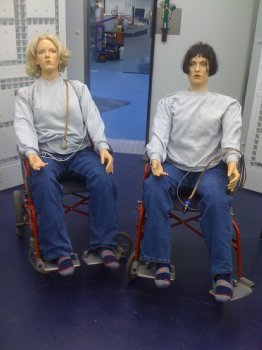
Thermal mannequins, 'Pamela' and 'Victoria'
A University of Ulster mannequin designed to test room temperatures has taken part in a multi-million pound climate change research project.
‘Pamela’ is usually based at Ulster’s Centre for Sustainable Technologies at Jordanstown, but she relocated to the University of Nottingham earlier this week to help find solutions for carbon reduction in solid wall homes.
This is part of CALEBRE (Consumer-Appealing Low Energy Technologies for Building Retrofitting) - a £2 million four year (2008-2012) project, funded by the EPSRC and E.ON UK.
‘Pamela’ joined fellow thermal mannequin, ‘Victoria’, from Loughborough University, at the specially designed E.ON 2016 Research House – a replica 1930s semi-detached house.
Currently our homes account for almost a third of the carbon dioxide emitted in the UK.
The government has set targets for all new homes to be zero carbon from 2016. But older houses will continue to emit carbon, this led energy company E.ON to build the 2016 Research House.
It provides a unique test environment that will help researchers develop innovative solutions for improving the energy performance of older properties.
The house enables practical assessments of the opportunities, implications and costs involved in modifying our older properties to minimise carbon emissions and reduce energy costs.
The mannequins will provide data on the thermal comfort of the house. Their body is split into elements that record the skin temperature and can report on the amount of cooling or heating that the various parts of the body is subject to.
Dr Philip Griffiths from Ulster’s School of the Built Environment said: “Until now such studies have required researchers to place people into the space and ask them to record how they felt, too warm, too cold or neutral.
“This can be subjective and requires a good sample of people to take part. ‘Pamela’ reports back a figure based upon the skin temperature, internal energy required, clothing levels and metabolic activity which can be used through established algorithms to provide a measure of thermal comfort. She can also be subjected to environments that are harmful to people.
“Pamela can be left unattended, unlike human subjects she doesn’t complain if we subject her to extreme environments, and is able to give consistent reproducible results.
“We hope to get an understanding from this field trial of how the temperature varies through a week with people using the building and the performance of the insulation materials inserted into the 2016 Research House.
“It will help us better understand how we can successfully refurbish existing dwellings so that we can reduce our energy requirements. Energy security of supply is just as critical as reducing the release of CO2 and other greenhouse gases.”
The University of Ulster will also be involved in the testing of vacuum glazing and air sources heat pumps at a later stage in the project.
Loughborough University is the principal investigator in the CALEBRE study working alongside research partners at universities of Ulster, Nottingham, Heriot-Watt, Oxford and Warwick.

Elsewhere on Ulster
- Study – Undergraduate, Postgraduate, Part-time, Research and Short Courses
- Global Students – Resources for Ulster University International Students
- Staff Links – Resources for Ulster University staff
- Students - The Student Guide to Ulster
- Staff – search and browse Ulster’s staff directory
- Portal - for Ulster University
- News – for Ulster University
- Events – for Ulster University
-
Ulster Homepage
















